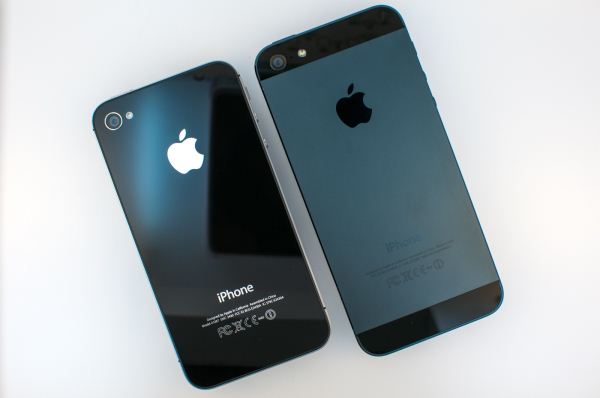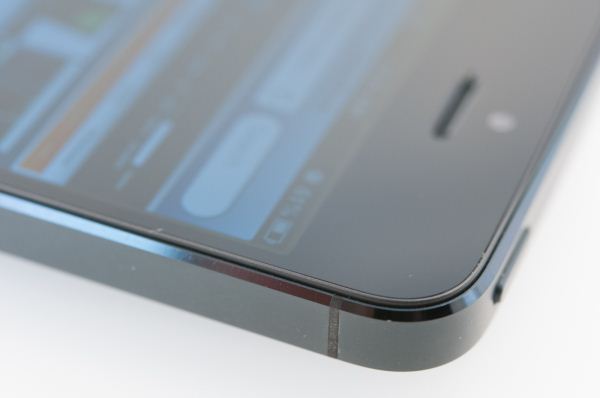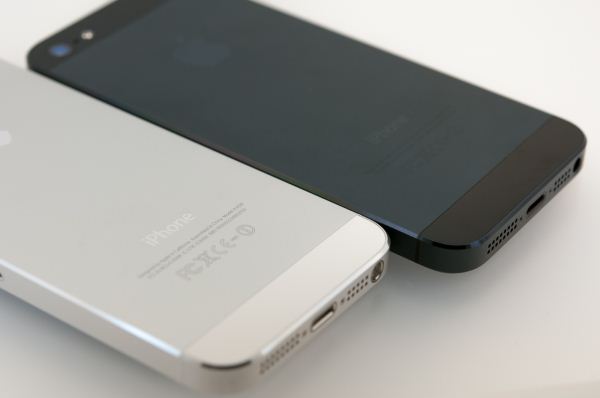The iPhone 5 Review
by Anand Lal Shimpi, Brian Klug & Vivek Gowri on October 16, 2012 11:33 AM EST- Posted in
- Smartphones
- Apple
- Mobile
- iPhone 5
Design
Section by Vivek Gowri
The iPhone 4, when it launched, represented a clean break for Apple's industrial design. It replaced the soft organic curvature of the iPhone 3G/3GS with a detailed sandwich of metal and glass, something that arguably brought the feel of a premium device to a new level. Obviously, Apple had their fair share of issues with the design initially, and nothing could match the sinking feeling of dropping one and shattering the glass on the front and back simultaneously, but it was a small price to pay for the jewel-like feel of the device. Combined with the (at the time) incredible pixel density of the then-new Retina Display, the iPhone 4 was a revolution in hardware design. The chassis has aged remarkably well over the last two-plus years, so naturally it's a hard act to follow.
The 5 keeps a similar design language to the 4, keeping roughly the same shape as before but with a taller and thinner form factor. At first glance, the 5 actually looks almost the same as the 4, with an unbroken glass front face, prominent corner radiuses, the familiar home button, a rectangular cross-section, and metallic sides with plastic antenna bands. However, those metallic sides are part of an anodized aluminum frame that makes up a majority of the body, and that's where the industrial design diverges from the 4 and 4S.
In contrast to the predominantly glass body of the previous generation iPhone, the 5 is almost entirely aluminum other than the glass front face and two small glass windows at the top and bottom of the back. It's a return to the original iPhone/3G/3GS-style of construction, with the front glass clipping into a unibody chassis. It's a significant departure from the 4 and 4S, where the stainless steel band in the center was the main housing that the front and rear panels clipped into. That was pretty radical way of doing things, so it's not all that surprising to see Apple revert to a more conventional and less complex method for the 5.
The aesthetic is actually pretty awesome, especially in the black version. The combination of black glass and off-black aluminum (Apple is calling it slate) gives the 5 an almost murdered out look that's three parts elegant and one part evil. The white and silver model has a classy look that's much friendlier in appearance than the black one. The color schemes and overall design aesthetic remind me of the Dell Adamo, one of my favorite notebook designs of all time. The similarities may be purely coincidental, but it's interesting to note nonetheless and should give you an idea of how premium the industrial design is.
All three previous iPhone body styles had very similar dimensions, so the biggest question with the 5 was how much the larger display would do to change that. Unlike many Android manufacturers, Apple still believes in things like small pockets, small hands, and one-handed smartphone usage. With the 5 being vertically stretched but no wider than the previous iPhones, the biggest impact on in-hand feel is actually the thinner body. If you're used to a larger Android or Windows device, the change seems radical, but even compared to the 22% thicker iPhone 4S, it feels a good deal smaller.
It's not just the minimized z-height though, the 25% weight loss is definitely also a factor. Even a few weeks later, I still find it striking how much less substantial it feels than the 4 and 4S. The densely-packed glass body just had a reassuring weight to it that the 5 simply lacks. But as you get used to the new form factor, you realize how far Apple is pushing the boundaries of ultrathin design. When the 4th generation iPod touch came out, I told Brian that I wanted an iPhone with that form factor - well, the 5 is essentially there (0.3mm thicker and 11 grams heavier, but close enough). It's pretty impressive to think about. If you thought the 4S was one of the best phone designs on the market in terms of aesthetics and build quality, the iPhone 5 just pushes that advantage further.



















276 Comments
View All Comments
Zink - Wednesday, October 17, 2012 - link
That's would be light enough to float.manders2600 - Wednesday, October 17, 2012 - link
It would be really nice to see some of these benchmarks next to an Android device running Jellybean.From my personal experience with the Galaxy Nexus, all of the benchmarks run in this article improve dramatically (many by more than 50%) with that OS version.
I'm really curious to see what a comparison between the performance of an S4 (Krait) and an A6 would be in that situation, since so much of the CPU tests are impacted by OS.
manders2600 - Wednesday, October 17, 2012 - link
But great read, though!. . . sorry, forgot to include that.
Tremendous research went into this, and it is well appreciated.
phillyry - Sunday, October 21, 2012 - link
I agree.I mean it's good that you have the devices on their native OSes but showing them on their upgraded OSes would bee good too 'cause it would add another realistic point of comparison.
cjl - Wednesday, October 17, 2012 - link
In the article, you state:"Which brings us to the next key detail with the anodization process: typically, the thickness of the anodization is half the thickness of the base aluminum. So if you had an aluminum plate that was 1mm thick, post-anodization, you would end up with a 1.5mm thick plate"
You also talk about the pore density in anodizing, and claim that apple has a pore density higher than most.
To put it quite simply, all of this is wrong.
Anodizing creates a layer that is on the order of micrometers thick. How thick the coating is depends on the details of the anodizing process, not on the thickness of the base metal. Most decorative anodized coatings are a few micrometers thick, and as you discussed, it's really not that hard to scratch them. Thicker anodizing, sometimes known as hard anodizing, is possible, and it can be done to thicknesses of 25 micrometers (0.001") or greater - from what I can find, over 100 micrometers is possible. These thicker coatings provide pretty substantial scratch resistance, and significant increases in durability, but they require substantially more process control, and it is more difficult to get a consistent coating. Note that even the thickest of these coatings is around 0.006 inches (150 micrometers) or so, which is far, far less than a 2:1 ratio on the aluminum on which it is applied. Interestingly, this thickest possible coating is about what you speculate is the thickness on the iPhone 5, but given its propensity for scratching, I sincerely doubt this to be the case.
Now for pores. The pore size on anodized aluminum is a few tens of nanometers. There is absolutely no way that you could visibly see this, or any improvement in this from one product to the next. This is 20 times smaller than the smallest wavelength of visible light. Quite simply, you can't possibly see this, and this won't be any different between Apple and any other manufacturer.
That having been said, there are some slight differences in pore structure between coatings. They won't make a significant visible difference (if any at all), but they can make a difference in durability. Specifically, hard anodized coatings (as mentioned above) tend to have thicker walled pores relative to the pore diameter. This again helps increase the wear resistance of hard anodized parts.
TL,DR: The iPhone probably has a really thin anodizing coat (<10 um). The pores are never visible on anodizing. Anodizing can be done, even on very thin aluminum, such that it would be incredibly scratch resistant.
Jaguar36 - Wednesday, October 17, 2012 - link
+1 on this.Not sure where the Vivek got the 2:1 ratio for an anodization thickness, but its nonsense. If you have a 0.25" thick part you're not going to be getting a 0.125" thick anodization. Anodization is usually less than 0.001" thick, and has no relation to the base part thickness.
Cibafsa - Wednesday, October 17, 2012 - link
Whilst Android based device manufacturers do not have to bear the majority of the SOC design/manufacture costs or the OS development costs, they do not share in the iAds/App Store type revenue Apple does.Surely it is Apple that can afford to cut prices to cost or even lower. Perhaps it is the Android manufacturers that have to worry about cheap high end phones.
Will be interesting to see what price point the iPad mini comes in at.
steven75 - Wednesday, October 17, 2012 - link
Most people following this industry are well aware by now that the App Store is run near break-even and iAds were not very successful.Calista - Wednesday, October 17, 2012 - link
A good and through review but I found it a bit too long-winded. An example would be the following example straight from the first page:'All previous iPhones have maintained the same 3.5-inch, 3:2 aspect ratio display. With the rest of the world quickly moving to much larger displays, and with 16:9 the clear aspect ratio of choice, when faced with the decision of modernizing the iPhone platform the choice was obvious.'
It could have been shortened to:
'iPhone 5 moves from the previously used 3.5", 3:2 aspect ration to a 4", 16:9 aspect ratio as common among smartphones of today. They kept roughly the same width while increasing the hight with xx mm. The resolution went from 960x640 to 1136x640."
More information is contained in the rewritten part while at the same time being shorter. Don't forget that this is Anandtech and I assume every single one of your readers are familiar with both the size and resolution of previous iPhones as well as common aspect ratios used on phones.
The same could be said about the design. I'm sure every single one of your readers have held and played with an iPhone 4/4s, and so when comparing to those two you guys could have kept a lot shorter.
phillyry - Sunday, October 21, 2012 - link
Read better as originally posted than as you rewrote it.